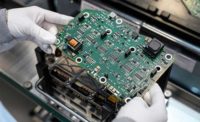SAN ANTONIO—Navistar International Inc. opened a new assembly plant here that will mass-produce electric trucks. The nearly 1 million-square-foot manufacturing facility includes a body shop, paint shop, general assembly shop and logistics center equipped to produce Class 6-8 vehicles.
The first vehicle off the line was an International eMV Series electric truck. However, the flexible facility has the capability to manufacture vehicles equipped with either electric or internal combustion engine power trains.
"The San Antonio [factory] was meticulously planned and constructed to highlight our many manufacturing strengths and build toward future manufacturing goals surrounding Industry 4.0 technologies, quality and sustainability, “ says Mark Hernandez, executive vice president of global manufacturing and supply chain at Navistar.
The plant will serve as Navistar's benchmark for lean manufacturing principles to eliminate waste, improve product quality, drive operational efficiency, and reduce cost and time. Industry 4.0 principles have been incorporated to connect digital and physical technologies, allowing the plant to be more connected and easily make data-driven decisions.
According to Hernandez, operating with a data-driven approach will help the company focus on sustainability goals and metrics, in addition to supporting a leaner manufacturing output.
"We are incorporating the latest manufacturing principles—digital factory, connected machinery, robust lean manufacturing processes and cloud analytics—to enable predictive quality and maintenance, and allowing data-driven decisions to be made on the shop floor in real time," says Hernandez.
"In support of our company focus, we are taking actions to reduce the environmental impact of our manufacturing operations with the goal of becoming zero carbon as we transform the future of transportation,” adds Hernandez.
Navistar’s new plant was constructed with energy efficiency and sustainability goals in mind. Translucent panels allow natural light to brighten the indoor space as a supplement to an LED system that consumes 75 percent less power than conventional lighting. The building also includes energy efficient wall paneling to better regulate indoor temperatures.






